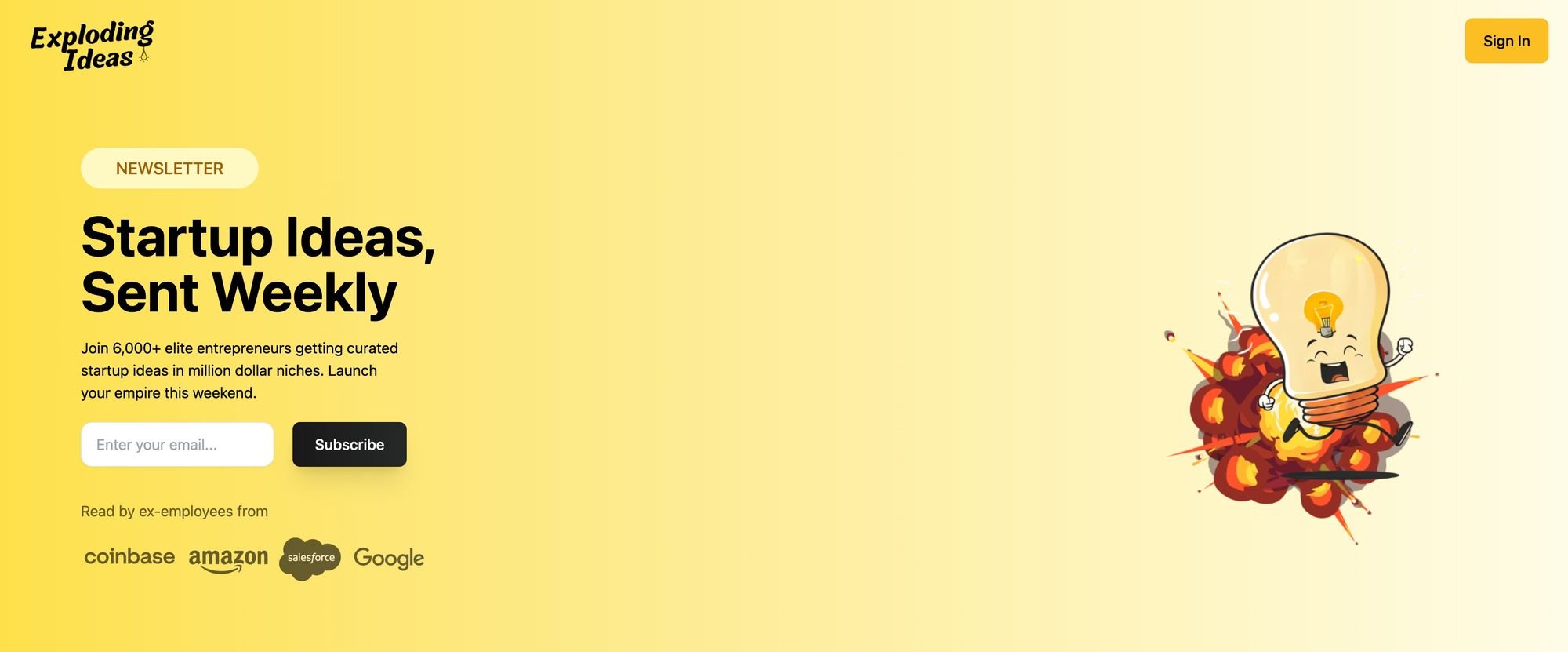In December 2022, I was starting to long for something more. I was working at a Venture Capital firm and was feeling the itch to create something new on my own.
At the firm, I was a portfolio manager and would run point on all the firm's founder relationships. Through those relationships, I noticed a trend: founders of startups are no different than anyone else.
I believe anyone can build a company as long as they have a clear vision, the market is right, they’re self-aware, understand the nuances of the industry, and they have the grit to power through the roadblocks.
After some time in Venture Capital, I took the knowledge I built around market research and started applying it to my personal life. I subsequently built three profitable bootstrapped online businesses in the music industry, one I successfully sold in 2021.
I have historically always balanced having jobs and online businesses. I think it’s important to have multiple revenue streams and ultimately be diversified, as you never know if you’ll lose your job one day or if the market will change.
The concept of “more” has always been a brush for me. I’ll typically work extremely hard at a company for some time and then want more for myself.
This has ultimately led me to my next idea; Exploding Ideas.co.

ExplodingIdeas.co is a weekly startup ideas newsletter in which I explore emerging trends and gaps in developing markets, showcasing to readers where the opportunities are and how to capitalize on them.
The rise of newsletters
In January 2023, I noticed an increase in reception around niche newsletters. Niche newsletter Milk Road had recently made headlines for selling to a private equity firm for over $1,000,000 after only ten months of business. Quickly thereafter, TheRundown.ai launched and quickly skyrocketed in popularity, getting on track to do $1,000,000/year after just four months of being online.
This insane influx of interest was all I needed to be convinced. It was clear that not only are people interested in these niche newsletters, but those newsletters can build up substantial value in them, unmatched by similar-sized social media accounts due to the monetization opportunities.
I then decided to start my own niche newsletter, ExplodingIdeas.co, and after four months, it’s made thousands in profit. Here’s how I did it and how you can ultimately do it too!
Identifying my newsletter niche
After deciding to dive head-first into building my own newsletter, I needed to figure out what trend I could take advantage of. Milk Road did well because it capitalized on crypto at peak popularity. The Rundown did the same when AI took off.
Even if I didn’t ride a market bubble, I still needed to find something with momentum to make sure I would easily attract people via an interest that existed in the market.
Looking at the overall market sentiment in April 2023, it was clear that there was a lot of uncertainty. Tech firms were laying off workers, AI was becoming a threatening narrative for further job displacement, and the stock market was heavily correcting from rising interest rates.
Whenever there is uncertainty and fear in the market, people are presented with pay cuts and potentially being laid off. As such, Maslow's hierarchy of needs becomes extremely important.
Maslow's hierarchy of needs is a motivational theory in psychology that comprises a five-tier model of human needs, often depicted as hierarchical levels within a pyramid. Long story short, it describes that when people are presented with the prospect of losing their income, which allows them to put food on the table, shelter over their heads, etc., it quickly becomes the only thing they can think about and consumes them.
This happens every time there’s a market downturn.
I decided to use that sentiment as my momentum catalyst and built a newsletter to give people in-depth insights into trending online business ideas that they could capitalize on as a side hustle. This would enable those who wanted to take action to build their own online businesses with just a computer and offer a potential solution to calm their anxieties about the more significant market deterioration.
I had built a couple of my own side hustles in the past and also did market research for Universal Music Publishing Group for years. Parlaying this knowledge into my own newsletter felt fitting, and the market timing felt perfect.
Building the initial audience
To build my audience, I identified an organic social channel to post about my newsletter and get subscribers for free.
As newsletters are content businesses, and I wasn’t sure how I would monetize it, I didn’t want to subsidize customer acquisition via ads as I felt that would give me an unsustainable method of acquiring subscribers. In order to grow a content business with no immediate revenue model, I needed to have a free method of growth.
In the past, I had built a couple of businesses off of Facebook private groups and Reddit by posting valuable content and funneling traffic to my landing pages, so I decided to take the same path with this. Facebook isn’t as popular as it used to be, so I decided to focus on testing out Reddit as my organic growth channel.
Looking at subreddits like r/Entrepreneur, there were many people asking for ways to come up with their own side hustles, and they were asking about how others came up with side hustles that ultimately earned them a full-time living. Speaking from experience, I decided to respond to those posts offering my advice on finding business ideas to capitalize on, and after providing the advice linked my newsletter as a resource.
I went to sleep, woke up, and was shocked – people were interested! I got 50 signups while I was sleeping.
I doubled down on this strategy to see how quickly I could reach 1,000 subscribers. I hit 1,000 subscribers in 12 days and spent $0 on customer acquisition costs.
At this point, I felt that if I just kept doing what I was doing, I could build something big and find a way to make money by listening to the community for what features they wanted and charging for them.
Turning it into a business
Launching paid features was tough. I wasn’t sure how people would receive the move as, up until this point, everything had been free.
Despite the anxiety and fear, I decided that after three months and 5,000 subscribers, I would launch a paid plan for subscribers who wanted deep business idea insights.
There would be two tiers:
- Tier one was freemium. It entitled subscribers to high-level business idea research every Sunday.
- Tier two included the Sunday business idea research and the new Tuesday Deep Dive. The Tuesday Deep Dive shares the SEO opportunities, Google Trends data, business ideas, and case studies for successful people already pursuing the idea and how to replicate it yourself.
I decided to launch tier two because the community of subscribers was emailing me asking me for more insights so they could act on the ideas I was sending out.
On the day of the launch, I got about eight signups which wasn’t thrilling but new subscribers started coming in every day, which was encouraging. It was apparent that I needed to take a longer view for onboarding paid subscribers, and it’s been growing a ton since then.
An interesting learning I had from that was immediately readers started emailing me asking for other features. Some readers wanted to speak on the phone with me to get my thoughts on their ideas as consultations, other readers turned out to be businesses, and they wanted to sponsor the newsletter with an advertisement.
I decided to roll out both as new features. I allowed companies to sponsor the newsletter every week, and I gave individuals the ability to have one-on-one meetings with me to go over their ideas and develop strategies.
These two additional revenue streams immediately moved the needle for the business. I had my first consulting gig within three days and my first newsletter sponsorship in the first week I launched it.
Making the newsletter profitable and sustainable
Acquiring subscribers for free via Reddit made it very easy to get profitable early.
I spent about $1,200 initially for an email service provider subscription (for a one-year subscription), a domain name, and a MidJourney subscription (to make the logo).
Since I kept the costs in the beginning super low, it forced me to be a scrappy entrepreneur and bootstrap the business. I had to develop the logo idea myself, art, fonts, etc., and do everything as cheaply as possible since I funded this out of my own pocket. I got to profitability in the first couple of weeks of turning on monetization.
Getting these subscribers for free via Reddit made them visit my website and sign up independently. I didn’t retarget them with ads; this was completely organic. Therefore my open rates and engagement rates have been high.
I always include polls in my emails, and this was the result of one of my first newsletter articles:
Working on engagement and retention
The significance of user engagement and retention in the newsletter business cannot be overstated. A newsletter is only as good as its readership, and maintaining high open rates and click-through rates is critical for its success.
To keep subscribers engaged, I sent out weekly polls and interactive content. The readers loved this approach as it gave them a sense of involvement and community. It also gave me helpful feedback and insight into what content and topics resonated the most with my audience.
To reduce churn, I regularly monitored email open rates and click-through rates. If a subscriber hadn't opened an email in a while, I'd send them a personalized email asking if there was anything more they'd like to see from Explodingideas.co. This level of personal touch worked wonders for retention and often sparked new content ideas.
Advice for aspiring newsletter operators
One of the greatest moments was hitting 5,000 subscribers within three months. Seeing my hard work pay off and being validated by thousands of people was indescribable.
However, the journey wasn't always smooth. There were periods of slow growth and instances where I questioned whether this could become a viable business. I remember launching the paid plan and anxiously waiting for sign-ups, only to have eight on the first day. Those moments tested my resolve and taught me that the reward isn’t always delivered via instant gratification.
My biggest takeaway from this journey is that understanding your audience is critical. Every successful step I took was a result of paying attention to what my subscribers wanted and tailoring the content and the service to their needs.
To those considering a similar path, my advice is to start with a niche you are passionate about and focus on delivering high-quality, engaging content. Be patient with your growth, and remember that your subscribers are not just numbers. They are people with interests, questions, and a desire to learn. Treat them as such, and they'll reward you with their loyalty.

